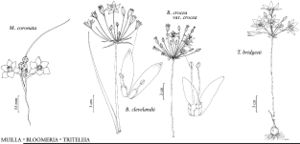Triteleia bridgesii
Bull. Calif. Acad. Sci. 2: 141. 1886.
Leaves 20–55 cm × 3–10 mm. Scape 10–60 cm, smooth except sometimes scabrous near base. Flowers: perianth lilac, bluish purple, pink, or reddish purple, 27–45 mm, tube strongly attenuate with slender base, 17–25 mm, hyaline vescicles present in tube, lobes abruptly spreading, 10–20 mm, shorter than tube; stamens attached at 1 level, equal; filaments triangular, widened toward base, 3–4 mm, apical appendages absent; anthers bluish, 3.5–4.5 mm; ovary 1/4–1/3 length of stipe; pedicel 2–9 cm. 2n = 16.
Phenology: Flowering spring (Apr–Jun).
Habitat: Foothills, yellow pines, mixed evergreen forests, often at forest edges and on rocks, dry bluffs, hillsides, mainly areas of serpentine
Elevation: 0–100 m
Discussion
Triteleia bridgesii is similar to T. laxa and in herbarium specimens can be distinguished only by the stamens. However, in fresh flowers, the perianth lobes of T. bridgesii spread abruptly from the throat of the perianth tube, unlike those of T. laxa, and the flowers of T. bridgesii are erect, while those of T. laxa are oriented horizontally. Triteleia bridgesii flowers a month earlier than T. laxa where they both occur in the Sierra Nevada foothills. The flowers in specimens of T. bridgesii from Humboldt County are unusually long, which accounts for the wide ranges of measurements for the perianth.
Selected References
None.
Lower Taxa
"broad" is not a number."/4lengthofstipe" is not declared as a valid unit of measurement for this property."thicker" is not a number.
